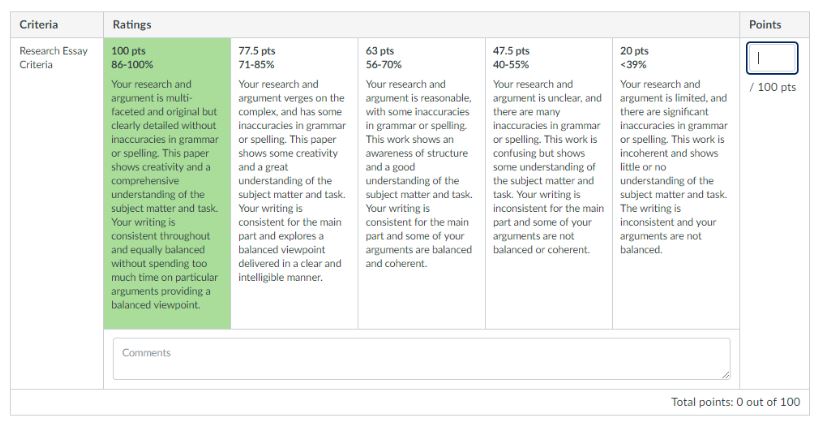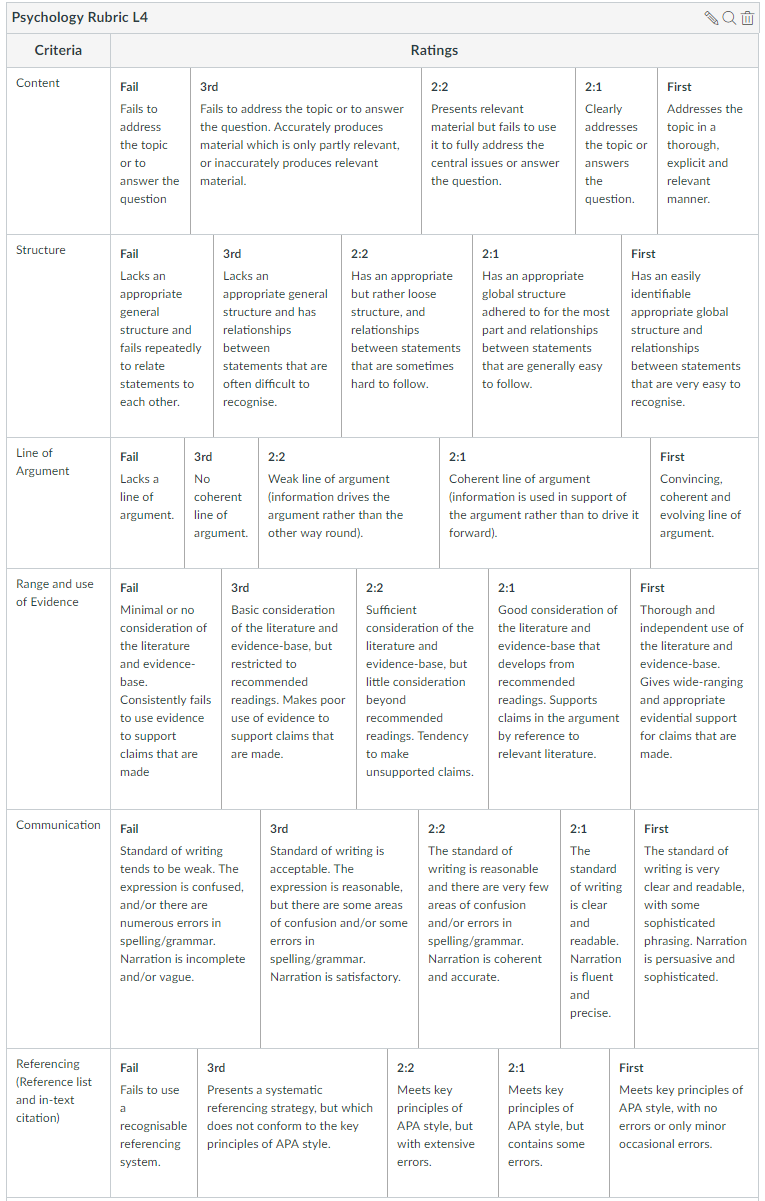Rubrics are a great way of marking student work and aligning feedback with module outcomes. They are easy to create and allow you to consistently mark work quickly using a pre-defined set of criteria. Rubrics are a useful tool for marking work, but they’re also a learning tool for students helping them set a pathway to high engagement and achievement. They can be added to assignments, quizzes and graded discussions and are a rich way of quickly delivering feedback.
What’s a Rubric?
Rubrics are generally categorised into either:
- Holistic – Are one-dimensional and use a single criteria to assess the whole body of student work at different levels.

- Analytical – Are much more granular and allow markers to use multiple criteria and level descriptors to assess a body of work.

Rubric provided by Psychology Programme Team, LJMU
What makes a good Rubric?
The TEL team have developed the mnemonic CLEAR to help you remember the important elements of a good rubric:
- Criteria- Ensure each criteria is meaningful and clearly described for each category to ensure your students understand what is required of them. Good rubrics use descriptive language.
- Level Descriptors – Provide clear and consistent characteristics for each performance level descriptor. It allows your students to identify their current strengths and identify the next steps they need to take to progress to the next level.
- Expectation – Allow your students to view the rubric before they start the assignment to ensure they learn what is expected of them.
- Aligned – Rubrics should be used to evaluate student work against the courses learning outcomes. Ensure criteria within your rubric is directly aligned with your courses learning outcomes.
- Review – Continually review your rubric to enhance criterion descriptors and ensure that it evaluates what it was intended to review.
How do I create a Rubric?
The clever people over at Canvas have created a range of guides to help you create your own rubric, you can find these guides and lots of other resources on the Canvas Community help pages.
Please note:
- Rubrics cannot be edited once they have been added to more than one assignment.
- When you delete a rubric, any course assignment currently associated with the rubric will still have access to the rubric, but it will no longer be available for future assignments in the Rubrics list.
What other useful features are there?
Rubrics are a great way of speeding the marking process to ensure students get their feedback promptly. Rubrics can be copied between courses, so that new rubrics can quickly be established in your new course without having to start from scratch. There’s also a really useful ‘save comment‘ option when using a rubric with free text comments, allowing you to quickly select existing comments written for a previous entry.
But do they work?
We’ve already outlined some of the reasons why rubrics are useful assessment tools, but are they effective learning tools? Brookhart and Chen in their review, explain that:
“evidence regarding the effects of rubrics on performance is positive overall. Evidence of the effects of rubrics on self-regulation of learning is mixed, though positive associations between rubric use and motivation to learn were identified in some studies.” (Brookhart & Chen, 2014).
This could be connected with how the rubric is introduced to the students and used by them. In another review of rubric use featured in The Assessment & Evaluation in Higher Education journal suggests that:
“…simply handing out a rubric cannot be expected to have an impact on student work: students must be taught to actively use a rubric for self- and peer assessments and revision in order to reap its benefits.” (Reddy & Andrade, 2009).
Further questions?
Canvas support are available 24/7 to answer your questions, login to Canvas and click on the help tab to live chat or call canvas.
Reference List
Andrade, H., Reddy, Y.M., (2009) A Review of Rubric use in Higher Education. The Assessment & Evaluation in Higher Education. 10.1080/02602930902862859.
Brookhart, S.M., Chen, F., (2014) The Quality and Effectiveness of Descriptive Rubrics. Educational Review. doi: 10.1080/00131911.2014.929565.
